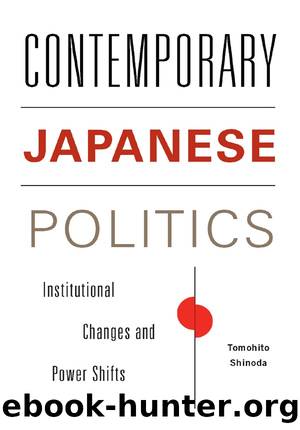Contemporary Japanese Politics: Institutional Changes and Power Shifts by Tomohito Shinoda

Author:Tomohito Shinoda [Shinoda, Tomohito]
Language: eng
Format: epub
Tags: International Relations, Political Science, General
ISBN: 9780231158534
Google: WSWtAgAAQBAJ
Publisher: Columbia University Press
Published: 2013-08-27T07:43:36+00:00
Inactive National Strategy Office
While the GRU drew media and public attention, the activities of the National Strategy Office were very limited. The original plan was to establish a bureau at the Cabinet Secretariat that would coordinate all policy areas. Deputy Prime Minister Kan, who was in charge of the NSO, was expected to play a pivotal role in policy making under the Hatoyama cabinet. CCS Hirano would play a more limited policy-making role and instead would concentrate on political affairs, serving as liaison between the government and the ruling parties. However, Kan could not establish a bureau without new legislation, which was never introduced to the Diet. With an office status (equivalent to the division, or ka, in the bureaucratic hierarchy), the GRUâs function was limited from the beginning.
Since 2006, when IchirÅ Ozawa became DPJ president, the party had had a troika system in which three leadersâOzawa, Hatoyama, and Kanâdivided the roles and responsibilities as described in chapter 4. Under the Hatoyama government, Ozawa, as DPJ secretary general, would be in charge of all party affairs, and Kan was expected to be in charge of policy affairs. To fully control policy affairs, Kan sought to assume the chairmanship of the DPJ Policy Research Committee. With the backing of the committee members, he would be able to exercise his power within the government. However, Ozawa strongly demanded centralization of policy making in the cabinet and abolished the partyâs policy committees. Kan now had to run the new office without any support from the party.
In addition, the jurisdiction of the NSO became more and more limited. At first the NSO was assigned to deal with all policy areas, including foreign policy. On the second day of the Hatoyama government, however, Foreign Minister Katsuya Okada denied the NSOâs involvement in foreign policy making unless the prime minister specifically assigned the task to the office.27 The NSO then was to focus on domestic policies, such as the budget, taxation, and economic management in general. But Finance Minister Hirohisa Fujii publicly stated that the budget would be decided by the Ministry of Finance, and that the NSO should focus on national strategy, as its name suggested. The NSO was at least supposed to replace the Council for Economic and Fiscal Policy, which formed the outline of the budget under the LDP government, as described in chapter 3. But the NSO had no mandate, no authority, no budget, and a very limited staff.
On October 13 the first NSO staffer recruited from the private sector went to the office to find only four desks without any telephone lines or other staffers. As of the end of October, the NSO had only twelve staffers, compared with fifty-nine in the GRU. Many people had applied for positions, but the NSO had no budget to hire them. All staffers were seconded from the ministries and large corporations.28 At the October 28 lower house floor meeting, LDP member Yasutoshi Nishimura criticized the inactivity of the office: âThe NSO has not done anything.
Download
This site does not store any files on its server. We only index and link to content provided by other sites. Please contact the content providers to delete copyright contents if any and email us, we'll remove relevant links or contents immediately.
| Comparative | Conflict of Laws |
| Customary | Gender & the Law |
| Judicial System | Jurisprudence |
| Natural Law | Non-US Legal Systems |
| Science & Technology |
American Kingpin by Nick Bilton(3756)
Future Crimes by Marc Goodman(3533)
The Meaning of the Library by unknow(2505)
Inside the Middle East by Avi Melamed(2305)
Why Nations Fail: The Origins of Power, Prosperity, and Poverty by Daron Acemoglu & James Robinson(2235)
On Tyranny by Timothy Snyder(2180)
Living Silence in Burma by Christina Fink(2038)
Putin's Labyrinth(1960)
The Mastermind by Evan Ratliff(1898)
The Smartest Kids in the World by Amanda Ripley(1801)
Think Like a Rocket Scientist by Ozan Varol(1780)
Law: A Very Short Introduction by Raymond Wacks(1699)
It's Our Turn to Eat by Michela Wrong(1683)
The Rule of Law by Bingham Tom(1651)
Philosophy of law a very short introduction by Raymond Wacks(1624)
Leadership by Doris Kearns Goodwin(1597)
A Dirty War by Anna Politkovskaya(1579)
Civil Procedure (Aspen Casebooks) by Stephen C. Yeazell(1510)
Social Media Law in a Nutshell by Ryan Garcia & Thaddeus A Hoffmeister(1496)
